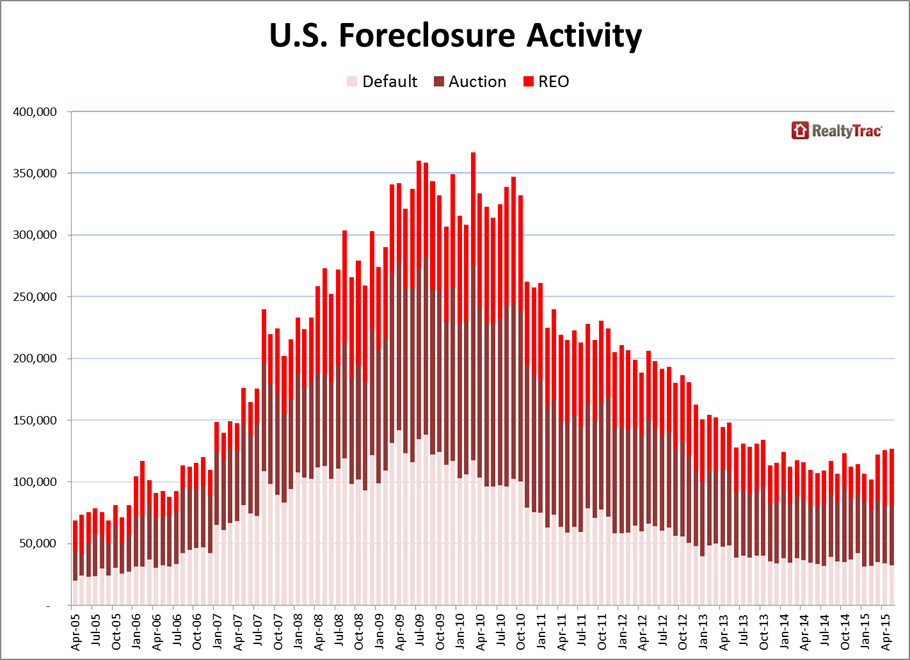Completed foreclosures - or what RealtyTrac classifies as REO - drove foreclosure activity in May to a 19 month high. The company's U.S. Foreclosure Market Report said that there was a foreclosure filing - default notices, scheduled auction, and REO or completed foreclosures - on a total of 126,868 properties during the month, one in every 1,041 housing units. The total was up 1 percent from April and 16 percent from April 2014.
Completed foreclosures affected 44,892 properties, 1 percent fewer than in April but up 58 percent compared to a year earlier. Scheduled foreclosure auctions, which were up 5 percent year-over-year also contributed to the high level of activity.

RealtyTrac said it was the third month in a row that REOs increased on an annual basis and scheduled auctions have increased year-over-year for four of the last eight months. May REOs were 56 percent below the peak of 102,134 REOs in September 2013 but still nearly twice the average monthly number of 23,119 in 2005 and 2006 before the housing bubble burst in August 2006.
"May foreclosure numbers are a classic good news-bad news scenario, with the number of homeowners starting the foreclosure process stabilizing at pre-housing crisis levels but the number of homeowners actually losing their homes to foreclosure still well above pre-crisis levels and on the rise," said Daren Blomquist, vice president at RealtyTrac. "Lenders and courts are pushing through stubborn foreclosure cases that have been languishing in foreclosure limbo for years as options to prevent foreclosure are exhausted or left untapped."
The increase in completed foreclosures was broad-based with 38 states and the District of Columbia posting higher year-over-year numbers. The largest increases were in New Jersey (up 197 percent), New York (up 116 percent), Ohio (up 114 percent), Georgia (up 108 percent), and Pennsylvania (up 106 percent). Florida, Michigan, and Maryland all saw increases of slightly more than 60 percent.
Foreclosure starts dipped 1 percent from April but were up 4 percent year-over-year, the first such uptick in four months. Twenty-five states posted annual increases in foreclosure starts led by New Jersey (up 73 percent), Virginia (up 39 percent), Missouri (up 19 percent), Massachusetts (up 14 percent), and Washington (up 11 percent).
A total of 49,413 properties were scheduled for a future foreclosure auction (scheduled foreclosure auctions are foreclosure starts in some states), up 6 percent from the previous month and up 5 percent from a year ago. U.S. scheduled foreclosure auctions so far this year are running about 40 percent higher than their pre-crisis levels from 2005 and 2006.
Twenty-six states posted increases in scheduled foreclosure auctions from a year ago, including New York which was up 118 percent. Increases in other states were much smaller with Illinois up 23 percent, New Jersey increasing by 22 percent, and Maryland up 11 percent.
Florida again led the nation in foreclosure activity with one in every 409 housing units with a foreclosure filing. Florida was followed by New Jersey (one in every 483 housing units), Maryland (one in every 531 housing units), Nevada (one in every 590 housing units), and Ohio (one in every 763 housing units).
Among the nation's 20 largest metropolitan statistical areas, 13 posted an annual increase in foreclosure activity in May, including Dallas (up 64 percent), St. Louis (up 56 percent), Baltimore (up 35 percent), New York (up 34 percent), Philadelphia (up 28 percent), and Atlanta and Detroit which were both up 27 percent.
Of metro areas with a population of over 200,000, those with the highest foreclosure rates were Atlantic City, New Jersey (a filing on one in every 230 housing units), Lakeland, Florida (one in every 331 housing units), Ocala, Florida (one in every 335 housing units), Miami, Florida (one in every 347 housing units) and Jacksonville, Florida (one in every 348 housing units).







